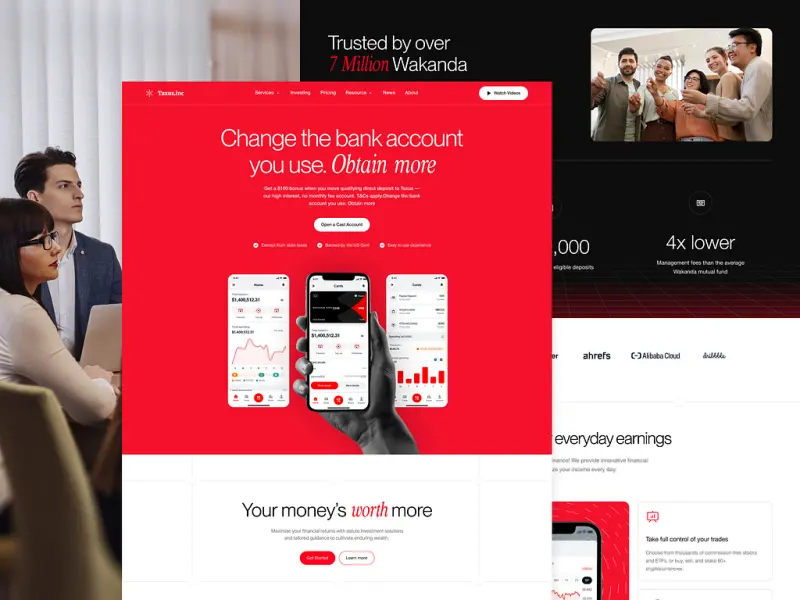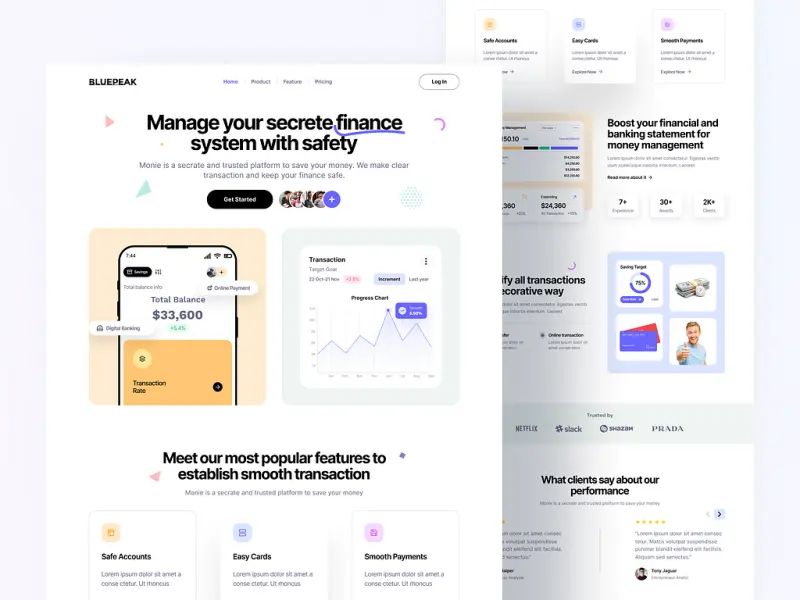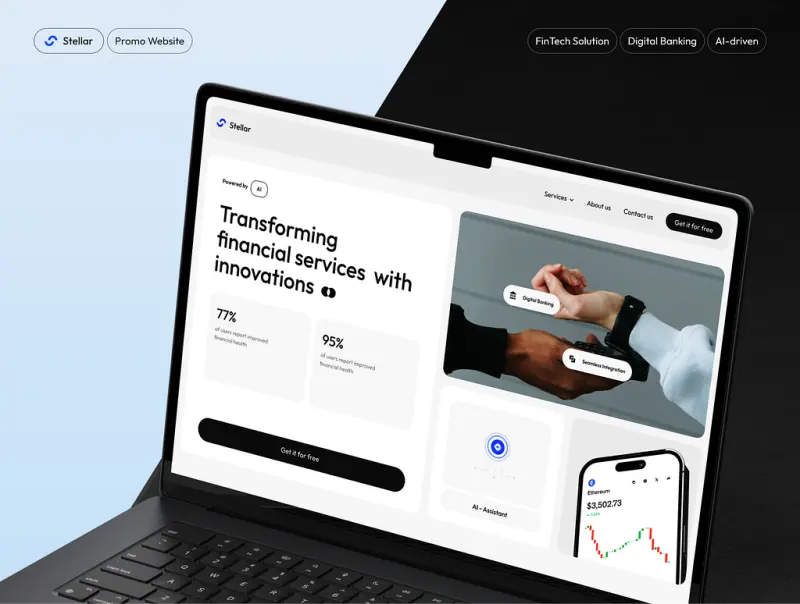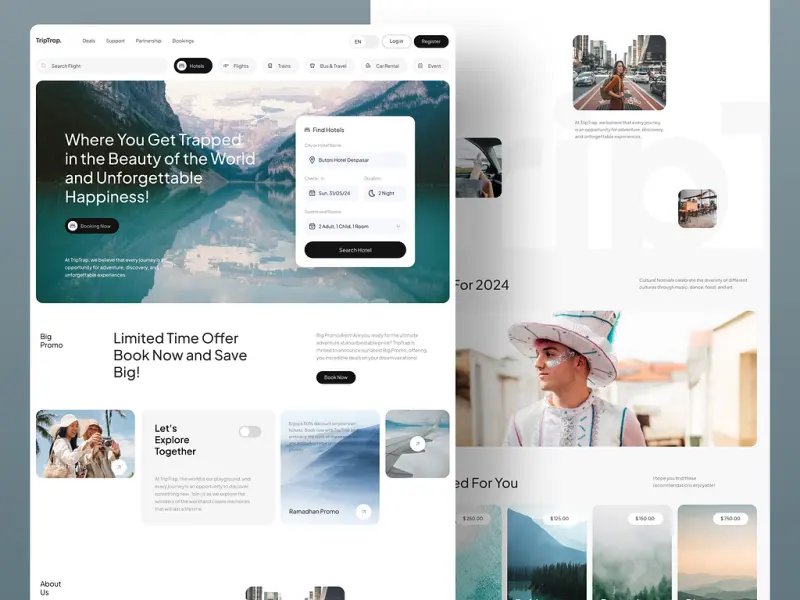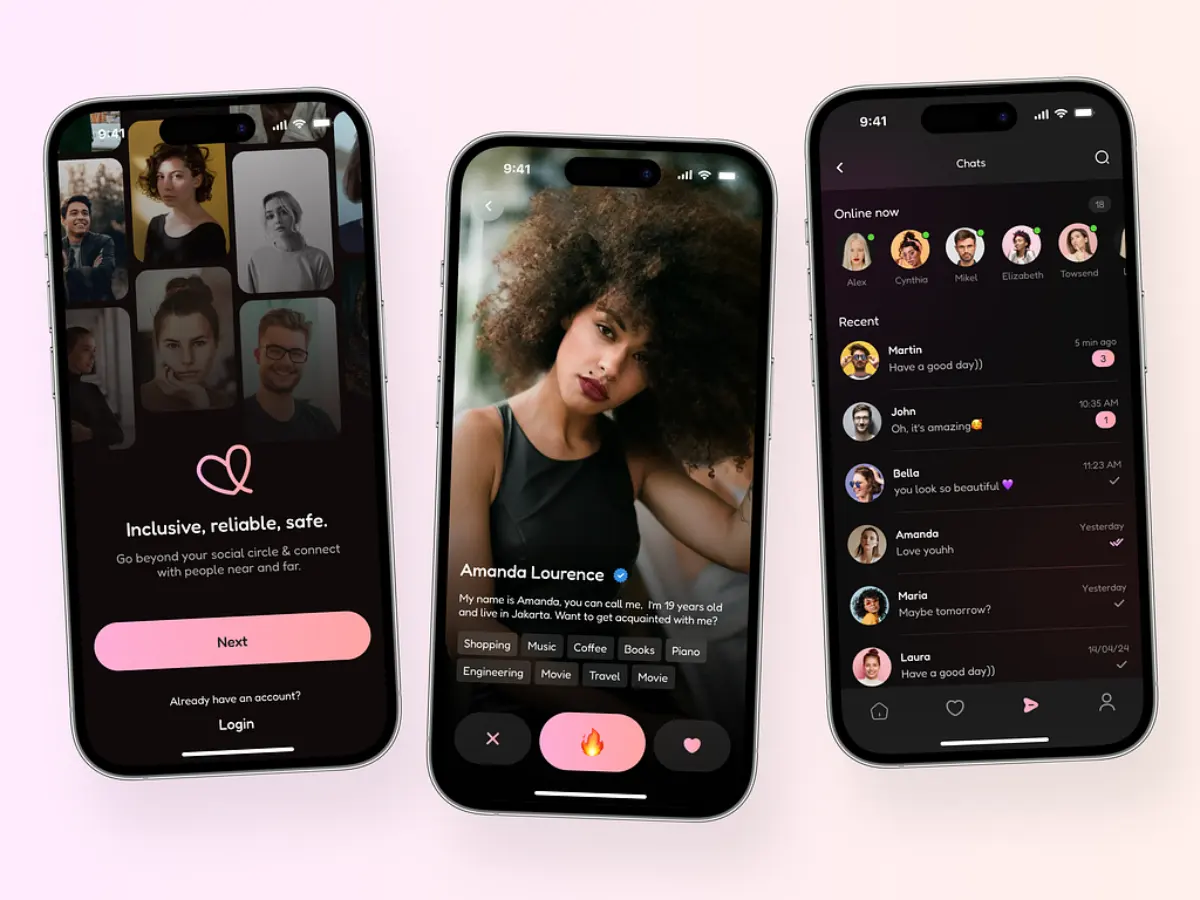How to Outsource Web Development: What to Know Before You Start
- TECHVIFY Team
- 0 Comments
You’ve started a business, and now you need a website. But no one on your team knows much about coding, and hiring a full-time web developer just isn’t in the cards right now. Sound familiar? If so, outsourcing your web design might be the perfect solution. Whether you’re a startup building your online presence or an established business looking for a website refresh, outsourcing can help you get there faster and more affordably.
In fact, according to the United States Bureau of Labor Statistics, there will be 17,900 new web development jobs opening up every year through 2030, with a 13% growth rate in the industry. That’s a lot of demand! But for many businesses, outsourcing to a freelancer or design agency is often the quicker and more wallet-friendly way to get the job done.
So, how do you make sure your outsourced project goes off successfully? It all comes down to finding the right partner, keeping the lines of communication open, and keeping the project on track from beginning to end. In this article, we’ll walk you through what it really means to outsource web design, why it’s a smart move, how to outsource web development, and how to do it right.
I. Important Reasons to Outsource Web Development
Many successful web applications started out as small projects and later grew into large businesses. One key factor that helped them scale was outsourcing their growing number of technical and other tasks, especially to web development companies.
Here’s a look at the top 5 reasons why outsourcing web development is a smart move:
Smart Use of Resources
A big reason why business owners opt to outsource web development is to save on costs. Instead of hiring and training a whole team of developers, designers, and project managers, you can bring in an outsourcing company that’s already fully equipped to handle your project. This not only saves you months of building an in-house team but also helps cut down on expenses like taxes, insurance, office space, and other employee benefits. In short, outsourcing helps you save two key resources: time and money.
Outsource web development
Access to Skilled Developers
To stay competitive, outsourced web development companies focus on assembling teams of talented and skilled professionals. By doing a bit of research—like checking reviews, recommendations, and case studies—you can find a team of experts that suits your needs. Later, we’ll dive into tips on how to pick the right team for your project.
Easy Project Scaling
Growing your web project is often a sign of business success, and outsourcing partners are well-prepared to help you scale. Since these agencies typically handle multiple projects, they have more staff available than you might need at any one time. If your project suddenly requires additional developers or designers, they can allocate the necessary resources quickly. This makes scaling your project with an outsourced team much easier compared to doing it with an in-house team.
Focus on What Matters Most
Outsourcing web development gives you the freedom to concentrate on your main business while specialists handle the technical side. Usually, your involvement is highest at the beginning of the project, when you’ll discuss the overall vision, design, features, and timelines. Once these details are set, you can step back and focus on your main business goals, checking in periodically to review progress.
Speedy Project Launches
Outsourcing web development can significantly speed up the time it takes to get your project off the ground. When you work with experienced developers, especially those with expertise in your industry, they can help you launch your website faster. You’ll also be able to validate your business idea, fix issues, and make improvements in a shorter timeframe.
II. A Step-by-Step Guide on How to Outsource Web Development
Outsourcing web development can be a game changer for your business, but to make it work, you’ll need to follow a few key steps. Here’s a simple guide to help you find the right outsourcing partner and ensure a smooth process:
1. Define Your Business Goals and Project Requirements
Start by clarifying what you want to achieve with your web project. Think about the type of website you need, the features it should include, and how it will serve your target audience. Ask yourself:
- What problems will the website solve?
- Who is your target audience?
- What kind of experience should your users have?
The more details you can outline at this stage, the easier it will be to communicate with potential outsourcing partners. A clear vision will help them grasp your objectives and create a solution tailored to your requirements.
2. Set a Budget and Timeline for Your Project
Your budget will play a big role in determining the complexity of your project and the type of outsourcing partner you can work with. While some advanced features may be tempting, be sure to balance your goals with what you can afford.
As for the timeline, you won’t be able to finalize an exact launch date until you’ve found your development team. Still, having a rough estimate based on the project’s technical requirements can help you filter out companies that won’t be able to meet your deadlines. More experienced agencies with skilled developers are often better equipped to deliver high-quality results within tight timeframes.
How to outsource web development
3. Identify Key Criteria for Your Outsourcing Partner
Before you start looking for a web development partner, make a list of what’s most important to you. This might include:
- Prior experience in your industry
- Location (offshore, nearshore, or onshore)
- Hourly rates and overall cost
- Company values and reputation
Having a clear list of criteria will help you narrow down your search to companies that align with your project’s goals and your business values. For example, if you’re developing an educational platform and care about sustainability, you might look for an agency with experience in that domain and a commitment to eco-friendly practices.
4. Select a Trustworthy Web Development Company
With your criteria in mind, create a list of 10 to 15 potential outsourcing companies that meet your requirements in budget, location, and expertise. Seek out firms that have a demonstrated history of success, including real reviews and case studies you can verify. Once you’ve compiled your list, reach out to these companies to ask questions, discuss your project, and get a feel for their communication style. From there, create a shortlist of the most suitable candidates.
5. Sign a Contract and NDA Agreement
Once you’ve chosen your outsourcing partner, it’s time to make the partnership official. A professional outsourcing agency will always recommend signing a contract to protect both parties. This contract should cover:
- The terms of the development process
- An initial budget for the project
- The roles and responsibilities of both sides
- Warranties and guarantees
- Key project definitions and milestones
Additionally, to protect your business information, you’ll want to sign a Non-Disclosure Agreement (NDA). This ensures that any sensitive data you share with the development team remains confidential.
6. Establish Clear Communication and Project Monitoring
Before the project kicks off, it’s vital to agree on how you’ll stay in touch and monitor progress. Make sure you and your outsourcing partner are on the same page when it comes to:
- A schedule for regular remote meetings
- Tools or platforms to manage time zone differences (if applicable)
- Deadlines for reviewing drafts and milestones
- The initial design concept and key development stages
- The budget and any potential changes as the project evolves
Setting these expectations upfront will make it easier to manage the project from afar and ensure there are no surprises along the way.
III. Know When You Are Ready to Outsource Web Development
Deciding when to outsource web development depends on the specific needs and experience level of your business.
If you’re a small business with limited knowledge in webdevelopment, it may be best to outsource your development tasks. However, if you’re a larger company with a skilled in-house team, you might feel more comfortable handling the work internally.
When to outsource website development
There are a few important things to consider when making this decision:
-
Experience and Skills: If your team doesn’t have much experience with web development, outsourcing to a specialized team can be a smart move. If your in-house team is experienced but lacks a specific skill, outsourcing for that particular skill set might be the answer.
-
Budget: Outsourcing costs can vary depending on factors like team quality, project length, and the tools or software needed. Be sure to weigh these costs against the benefits of outsourcing.
-
Timeline: Make sure the timeline for your project aligns with the capabilities of the outsourcing team. Clear communication on deadlines is key.
Finally, it’s crucial to keep communication open with your outsourcing partner. Make sure they understand the project scope, timeline, and specific requirements. A well-managed outsourcing arrangement can save you both time and money, so don’t hesitate to explore this option!
Looking to Outsource Development?
Contact TECHVIFY – Vietnam’s Leading Offshore Software Development & Outsourcing Company, for consultation and development services.
IV. Tips to Choose the Right Outsourced Development Partner
Outsourcing web development has become a popular solution for many entrepreneurs, offering ways to cut costs, access top talent globally, and speed up time-to-market. However, understanding how to outsource web development is not enough; the key to a successful outsourcing experience lies in choosing the right development agency. To help you make the best decision, here are some tips to guide you through the process:
1. Check the Agency’s Reputation
Before you commit to working with an agency, it’s crucial to verify their reputation. While most companies will highlight their successes, you’ll want to dig deeper to get a complete picture. Simply relying on the reviews and case studies on their website isn’t enough. Instead, visit independent platforms like Clutch, GoodFirms, and Upwork where you can find genuine feedback from past clients. On these platforms, you can even reach out to former clients directly to ask for honest insights about their experiences. Additionally, don’t forget to explore the agency’s presence on social media, their corporate blogs, and relevant industry news. All of this will give you a clearer understanding of their track record and reliability.
2. Look for Industry-Specific Experience
When choosing an outsourcing partner, it’s a good idea to look for companies that have experience in your specific industry. For instance, if you’re developing an online medical assistant app, partnering with a web development agency that has successfully built healthcare applications will increase the chances of a smooth project. Their relevant expertise means they’ll better understand your needs and the challenges of your field, which makes it more likely they’ll deliver the results you’re looking for.
3. Foster Strong Communication
Clear communication is key to building a successful partnership, and it’s something you should prioritize when selecting an outsourcing agency. Being on the same page ensures that project expectations are met and that the entire process runs smoothly. Here are a few questions to ask yourself during the negotiation phase:
- Are my requests and requirements clearly understood by the team?
- Are there any cultural or language barriers causing confusion or discomfort?
- Is the time zone difference being managed well, and are remote meetings scheduled at convenient times?
- How quickly do they respond to my questions and provide feedback?
The more effort you and the agency put into establishing clear communication, the more productive and efficient the collaboration will be. Make sure both sides are working toward mutual understanding from the very beginning.
What’s the Cost to Outsource Web Design?
The cost of outsourcing web design can differ based on various factors, including the complexity of the project and the region where the outsourcing partner is located. Whether you’re building a website from scratch or redesigning an existing one, understanding what influences the price will help you plan your budget more effectively.
Factors That Impact Outsourcing Costs
Two major factors influence the cost of outsourcing web design:
1. Complexity of the Website’s Business Logic
Business logic refers to the algorithms and rules that handle the exchange of information between the user interface and the database. The more complex the business logic, the higher the design and maintenance costs.
For example, a simple social networking site might start with basic functionality, but if you later add features like video chat, e-commerce, or content streaming, the complexity increases. This, in turn, raises the cost of design, development, and ongoing maintenance.
Websites with more features and multiple user roles will cost more to design and maintain, so you need to assess the business logic carefully before outsourcing to ensure you get accurate cost estimates.
Outsource website development
2. Complexity of the Design
The complexity of the design also has a significant impact on the cost. Simple designs are quicker and cheaper to create, while more intricate, custom designs take more time and effort, driving up the price.
For example, a streaming platform like Netflix has a highly complex design requiring multiple user interactions and layers of functionality. Designing such a platform takes more time and specialized skills, which affects the cost.
Custom Web Design
Custom web design offers endless possibilities, but it also directly affects the cost. Here’s an example of a typical custom website design:
- Pages: 15–20
- CMS: WordPress
- Templates: 4 (Home, Contact, Landing, Informational)
- Web design: Responsive
- Forms: 3 (Contact form, lead magnet, exit pop-up)
To complete such a project, a designer might need at least 45 hours for the design phase, 45 hours for development, and 10 hours for testing. Outsourcing companies usually charge on an hourly basis, and the more custom features there are, the higher the overall cost.
Native Design Libraries (e.g., Google Material)
Native design libraries, like Google Material Design, use native code compiled for specific operating systems or hardware architectures. Developing with these libraries requires specialized skills, which can also affect the cost of outsourcing your web design project.
Regional Cost Breakdown for Outsourcing Web Design
The region where you outsource your web design project significantly impacts the cost. Here’s a general overview of what you can expect in different parts of the world:
Cost in North America
North America is generally the most expensive region for outsourcing web design. However, if you need highly specialized expertise or have complex project requirements, it might be worth the investment. Web design firms in this region often have teams with skills in UX, UI, and interaction design.
| Designer Skills | Average Salary (approx.) |
|---|---|
| User Experience Design | $77,000 |
| User Research | $80,000 |
| User Interface Design | $76,000 |
| Interaction Design | $76,000 |
- Average Hourly Rate: $40 per hour
- Cost for a 160-Hour Project: $6,400
Cost in Latin America
Latin America offers a middle-ground option in terms of cost. Countries in this region have become increasingly competitive in the tech sector, and many firms deliver quality web design services at reasonable rates.
| Designer Skills | Average Salary (approx.) |
|---|---|
| User Experience Design | $15,000 |
| User Research | $19,000 |
| User Interface Design | $14,000 |
- Average Hourly Rate: $25 per hour
- Cost for a 160-Hour Project: $4,000
Cost in Eastern Europe
Eastern Europe is another popular region for outsourcing web design, offering a good balance between cost and quality. Agencies in this region often provide full-cycle services that include project management and business analysis, which can add value to your project.
| Designer Skills | Average Salary (approx.) |
|---|---|
| User Experience Design | $8,000 |
| User Research | $10,000 |
| User Interface Design | $9,000 |
- Average Hourly Rate: $35 per hour
- Cost for a 160-Hour Project: $5,600
Cost in Southeast Asia (Vietnam)
Countries in Southeast Asia, such as Vietnam, are known for offering lower-cost outsourcing options without compromising on quality. In Vietnam, for example, the average base salary for a web designer is lower than in many other regions, making it a cost-effective option for outsourcing web development work.
| Designer Skills | Average Salary (approx.) |
|---|---|
| User Experience Design | $7,000 |
| User Research | $9,000 |
| User Interface Design | $8,000 |
| Interaction Design | $10,000 |
- Average Hourly Rate: $20–$25 per hour
- Cost for a 160-Hour Project: $3,200–$4,000
Looking at the cost breakdown across various regions, Vietnam clearly stands out as the most cost-effective option for outsourcing web design. For businesses looking to maximize value, TECHVIFY is an excellent partner in Vietnam. We provide not only affordability but also expertise in scalability, security, and engineering. They offer comprehensive consultancy services, ensuring your project is well-designed, scalable, secure, and technically robust to support your business’s growth. By choosing Vietnam and TECHVIFY, you gain a reliable partner capable of delivering high-quality web development solutions at a fraction of the cost.
Conclusion
Outsourcing web development is a smart, cost-effective solution for businesses of any size, whether you’re a new business wanting to build your online presence or a well-established company seeking a website refresh. By having a grasp on how to outsource web development and tapping into the skills of external developers, you can save time, cut costs, and benefit from skilled professionals who can help you scale your project quickly and efficiently.
If you’re ready to save time and money while getting access to top-tier development talent, now is the time to act. Contact TECHVIFY today for a free consultation and see how we can help you build, scale, and secure your next web development project. Let TECHVIFY be your trusted partner in delivering high-quality, cost-effective web solutions that drive your business forward.
TECHVIFY – Global AI & Software Solutions Company
For MVPs and Market Leaders: TECHVIFY prioritizes results, not just deliverables. Reduce time to market & see ROI early with high-performing Teams & Software Solutions.
- Email: [email protected]
- Phone: (+84)24.77762.666




